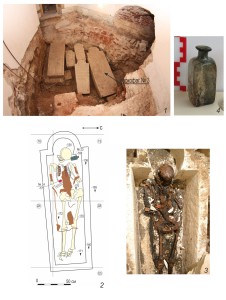 Leonid A. Belyaev,* Irina I. Elkina,* Anna V. Rasskazova,** Mariya B. Mednikova**
Leonid A. Belyaev,* Irina I. Elkina,* Anna V. Rasskazova,** Mariya B. Mednikova**
*Institute of Archaeology RAS, Moscow, Russia (labeliaev@bk.ru, ira-elkina@yandex.ru, taa-volga@yandex.ru, medma_pa@mail.ru)
**Institute of Ethnology and Anthropology RAS, Moscow, Russia (rasskazova.a.v@yandex.ru)
Keywords: Novospasskiy Monastery, Sarcophagus 3, ‘Nikitichs’ Romanovs, silk shirt, ointment vessel, seal of the chart with an absolving prayer, X-ray fluorescent analysis, physical anthropological analysis, microfocus digital rentgenography, three-dimensional digital model, graphic skull reconstruction, hylological examination.
In December 2014 a team of researchers of the Institute of Archaeology RAS opened a stone Sarcophagus 3 of the Moscow Novospasskiy Monastery. The finds including the remains of a silk shirt embroidered with metal threads, an unusual ointment vessel and a seal imply a high status of the deceased, which is moreover evident from his interment in a princely cemetery. The burial can be preliminarily dated to AD1610–1650.
A subsequent analysis involved the reconstruction of the outward appearance of the deceased, the characteristic of his physical development, the determination of his biological age and the state of health in the period prior to the death as well as a detailed hylological investigation of his dress and the seal of the chart with an absolving prayer. The materials’ examination implemented modern microscopy techniques and the X-ray f luorescent analysis.
The deceased was a teenager 13–15 year old regarded, however, as a high-status adult. It is worth noting that the length of the sarcophagus (210 cm) corresponds to that of an adult’s body far exceeding that of the boy. At the same time, judging from isotopic analysis, the diet of the child was not that of social prestige, which can be accounted for by an unfavorable historical period having coincided with that of his growth. This assumption is also substantiated by numerous traces of physiological stresses undergone in childhood and adolescence revealed by the examination of the remains.







